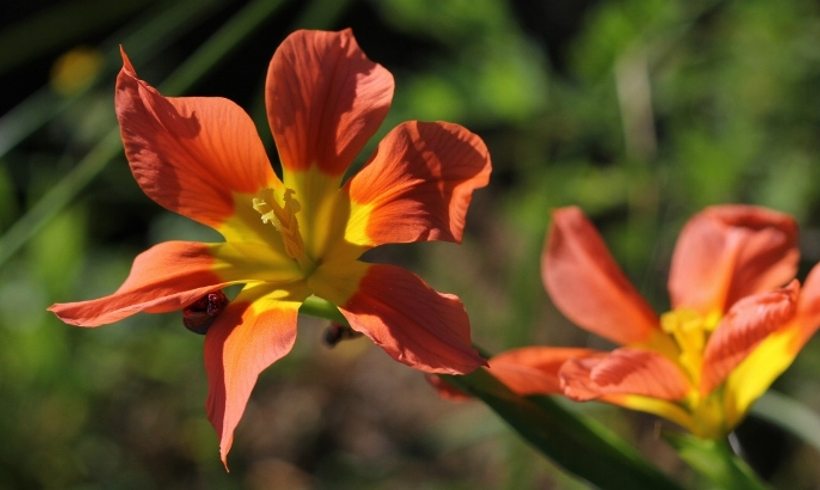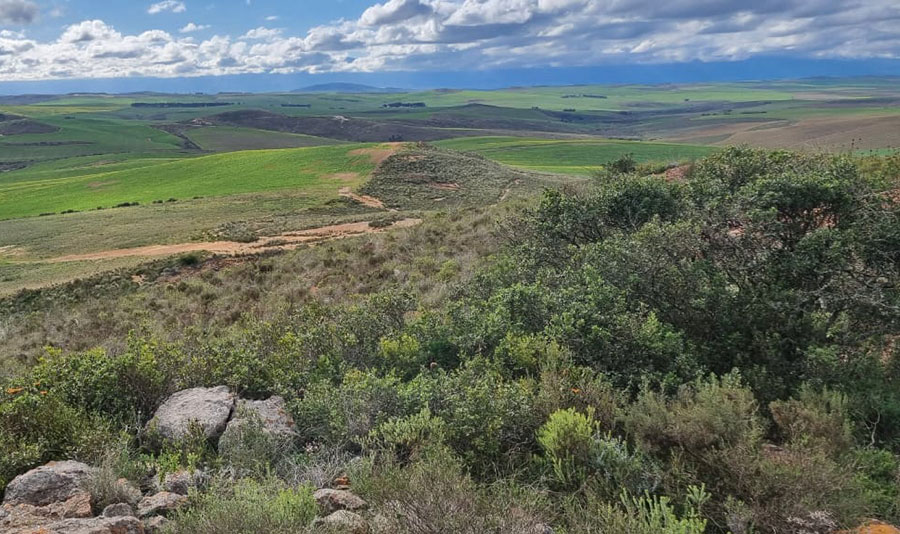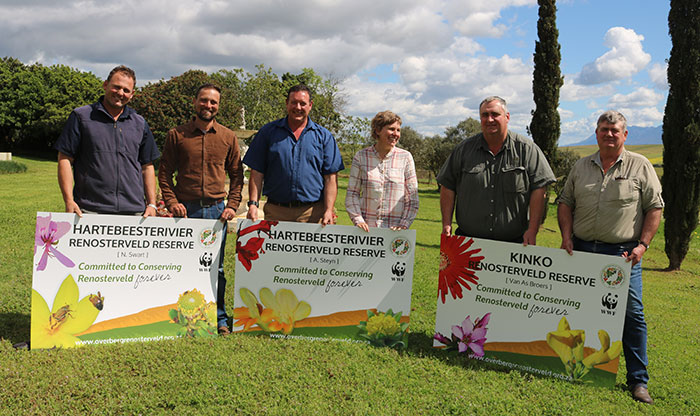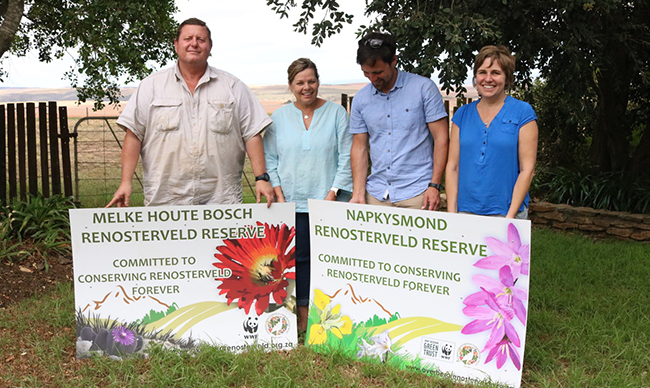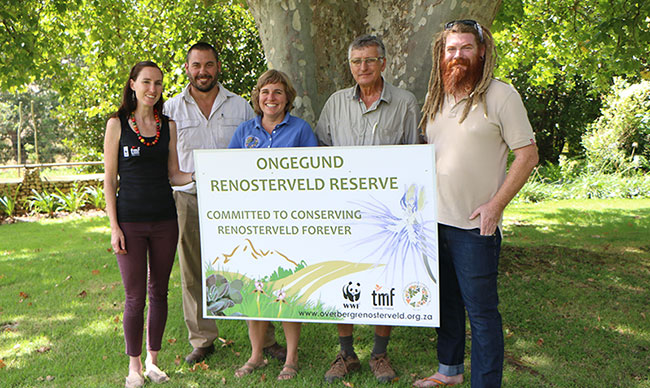Conservation Easements in the Overberg
We work with farmers and landowners with Renosterveld on their property. It’s voluntary to sign a conservation easement, and through easements, we work together to protect these landscapes.
Here’s how it works:
- Either farmers approach us to sign an easement, or based on a set of criteria, including things such as: fragment size and/or connectivity, fragment quality (in terms of management effects), biodiversity value (based primarily on plants, birds and other taxa where possible), we will start a conversation with landowners. We want to protect vital remaining Renosterveld fragments together.
- If the landowner or farmer is willing to learn more, we present them with a full report on the biodiversity value of their farms. Discussions follow regarding management requirements and ways in which the ORCT can assist.
- If a landowner commits to signing an easement, our Ecological Coordinator draws up a draft Management Plan, which is completed with the landowner’s inputs and approval.
- Once the landowner is happy with the Management Plan and signs off on it, the legal paperwork is drawn up by our Ecological Coordinator and legal advisors.
- Then the easement is signed by the ORCT and the farmer, and registered at the Deed’s office.
- At this point, we work with the landowner/farmer to implement priority management interventions as highlighted in the management plan. These may include:
– Fencing patches to manage livestock access
– Clearing invasive alien plants
– Planning and supporting ecological burns
– Erosion control
– Undertaking ecological surveys to see what species (plants and animals) are found in the Renosterveld
– Monitoring growth post-burn
– And much more.
Got a question? Here are some frequently asked questions from our farmers.
A: Yes. But we recommend following the grazing guidelines in the Management Plan as much as possible in order to avoid overgrazing and long-term negative impacts.
A: We recommend at least two growing seasons, with only summer grazing thereafter.
A: Yes, you may; as long as they are not in watercourses and as long as they have been designated on the maps associated with your invasive alien plant management plan. For example, a grove of Bluegums can be retained for shade or bee-keeping, but this should be clearly shown on the map in your Management Plan.
A: Not necessarily. Feeding livestock within natural veld areas introduces several weeds and alien grasses – we therefore discourage it. However, we also recommend sticking to one or two intensively used areas, rather than moving feeding areas around the farm. Ideally they are managed as part of your overall veld and farm management.
A: No, but where possible, we assist with fencing larger areas, in order to optimise livestock management in the veld.
A: No, definitely not. It is illegal to plough Renosterveld irrespective of whether or not you sign a conservation easement. The partnership that you create with the ORCT in signing such an agreement provides the platform from which you can access funding and assistance to improve your veld management, adding value to your farm.
A: Yes. We will make sure that your Management Plan takes all relevant environmental legislation into account, making you 100% compliant with the laws, as long as you stick to the plan.
A: No. Signing the Conservation Easement and the associated Management Plan has the advantage of bringing you in line with all environmental legislation (particularly regarding the laws which state that you may not sell a property containing invasive alien plants). It also forces the next landowner to acknowledge where the virgin land is, hopefully adding another layer of protection to the vegetation which you have worked so hard to conserve. The idea is that you yourself would want to prevent future owners from destroying or degrading the Renosterveld on your farm – it’s the only way to leave this legacy.
SOUTRIVIER
Unlocking renosterveld’s value through this NEW easement
This easement brings 160 hectares of Critically Endangered renosterveld under protection in perpetuity. The farmers who signed are from Klipdale Boerdery, which has four commercial farmers in this joint venture. These include two farmers (Adriaan Steyn and Neethling Dippenaar) who are already part of the Conservation Easement Programme for renosterveld in the Breede River area.
PLAATJIESKRAAL
Global partners team up to protect renosterveld
This conservation team has collaborated to buy a key potion of property situated 40km south of the town of Swellendam, called Plaatjieskraal. The farm borders on the 500-hectare Haarwegskloof Renosterveld Reserve
MUURKRAAL EASEMENT
The puzzle pieces fit as a key easement is signed
“Piece by piece our Renosterveld puzzle, to connect and secure the remaining fragments of Overberg Renosterveld, is coming together.”
HARTEBEESTERIVIER CLUSTER
Three new easements signed: Connecting Renosterveld fragments forever
With three more conservation easements just signed, severely threatened Renosterveld corridors between Swellendam and Heidelberg are now connected in conservation forever. These three easements, signed with the Overberg Renosterveld Conservation Trust (ORCT), conserves 427 hectares of Endangered Eastern Rûens Shale Renosterveld and 32 hectares of Critically Endangered Rûens Silcrete Renosterveld.
VOGELRIVIER EASEMENT
Realising a conservation dream
“We had already secured much of the headwaters of the Sout River through the signing of the Kleindam easement, as well as some important sites along the river (Kykoedie and Keykas easements) Now with Vogelrivier, we have secured the end of the river, leading into the De Hoop Vlei.“
DIPTKA, KOLONIESPLAAS, KLEINDAM AND KOESANI EASEMENTS
FOUR easements in one day (an exciting end to 2020)
This is the way to close off 2020 – by signing FOUR conservation easements, and securing 650 hectares of Critically Endangered Renosterveld forever.
SIJNN WINES EASEMENT
Sijnn Wines makes the ultimate conservation commitment
According to Sijnn Wines owner, David Trafford, the Renosterveld makes up a significant portion of the property. “We take a lot of pride and effort to look after this piece of land, which has never been touched nor damaged.”
UITVLUCHT EASEMENT
This farming family’s dedication to conservation
The Polhillia brevicalyx is only found on the Streicher’s farm, Uitvlucht, and a number of neighbouring farms in the Ouka River system (also known as the Freek Botha River). This river runs through the farm and neighbouring properties, before joining the Riviersonderend River.
MELK HOUTE BOSCH AND NAPKYSMOND EASEMENTS
“I first wanted to develop on my Renosterveld”
Hennie actually wanted to develop parts of his Renosterveld for agricultural expansion. But during the Environmental Impact Assessment process, he saw the Renosterveld – and all the wildlife that lived in these patches – in a new light.
CAMERON MCMASTER EASEMENT
Cape Agulhas Municipality commits to Renosterveld conservation
The Napier site will be called the ‘Cameron McMaster Renosterveld Reserve’, named after the Renosterveld expert who died in 2018. Cameron and his wife, Rhoda, assessed the Napier site, and determined that it’s home to a greater diversity of bulbs than the world-famous botanical destination, Nieuwoudtville.
KEYKAS EASEMENT
“For Renosterveld, and for my father”
There’s a reason why farmer, Nico Neethling, chose to sign his conservation easement HERE. It not only overlooks the patch of Renosterveld he’ll be protecting forever. It’s also next to the grave of his father, on their family farm, Keykas, close to Klipdale in the Overberg.
ONGEGUND EASEMENT
Why this farmer has teamed up with us – to protect his Renosterveld
Renosterveld species we’re particularly excited about on his farm include the Endangered Babiana purpurea and Acrodon subulatus, as well as the Vulnerable Gladiolus abbreviatus. And of course beauties such as the Bartholina burmanniana.
DASBERG AND SWAYNEKLOOF EASEMENTS
Secured forever: Another 342ha of pristine Renosterveld
These farmers have both now signed conservation easements, (conservation servitudes attached to title deeds in perpetuity), which ensures their Renosterveld patches are protected and carefully managed.
KYKOEDIE EASEMENT
A little bit of history for the ORCT
We’ve teamed up with landowner, Joshua Human, on the farm Kydoedie. Joshua is passionate about protecting his Renosterveld patches. And so decided to make his commitment to conservation formal, through an easement.
KLIPFONTEIN RENOSTERVELD RESERVE
The first conservation easement in South Africa focused specifically on protecting Renosterveld was signed in 2017.
WWF-South Africa signed with a Caledon landowner, MG Lötter. The Overberg Renosterveld Conservation Trust (ORCT) manages the easement and provides the management support to Lötter and other landowners who have signed up.




